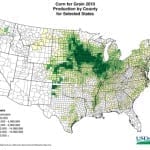Grain analysts are expecting those guarantees to fall yet again for corn, soybeans, and spring wheat, this year. According to recent predictions from grain analysts, the crop insurance price guarantees for American spring wheat, corn, and soybeans is going to fall by another 10 percent, this year, based on an analysis of February futures settlement prices. The USDA provides a subsidy for a minimum of two thirds of the insurance premiums paid by farmers. The crop insurance program, itself, has oversight by the USDA Risk Management Agency (RMA), which also…
Read MoreTag: crop insurance program
Crop insurance claims already increasing in Canada
As another summer comes with devastating flooding, farmers are already contacting their insurers. As farmers begin to have the opportunity to see how much of their land has been affected by flooding in Saskatchewan, Canada, they are submitting their crop insurance claims on an increasing basis. It is believed that the full impact of the flooding throughout Saskatchewan will not be known until the fall. According to Rae Groeneveld, from the Saskatchewan Crop Insurance Corporation, by July 29, there had already been 792 claims submitted, pre-harvest. He explained that “A…
Read MoreCrop insurance program wastes $7.8 billion, says environmental group
A new report has suggested that farmers in the Corn Belt have been massively overcompensated. The results of an analysis that was commissioned by the Environmental Working Group (EWG) have now been released in a report which suggests that the federal crop insurance program’s compensation to farmers in the Corn Belt who experienced the greatest devastation from the drought in 2012, had actually been too high by an estimated $7.8 billion. The payouts from that disaster totaled approximately $14 billion, but the report said that far less would have sufficed.…
Read MoreCrop insurance receives more legislative attention in the US
Legislators again consider crop insurance reforms Crop insurance in the U.S. is often criticized as being a major financial drain on the federal government. This type of insurance coverage is part of the federal government’s safety net for farmers, which is meant to provide farmers with financial support in the event of natural disasters and to ensure that they have an incentive to produce crops. The country’s crop insurance program has become the target for those seeking reform, with some federal lawmakers suggesting that the program encourages farmers to adopt…
Read MoreCrop insurance subsidy limits applauded by reformers
Those in favor or restrictions of this nature gave their praise to a U.S. House of Representatives vote. Reformers for the crop insurance subsidy gave their approval to a vote that was held by the U.S. House of Representatives that would require the wealthier growers to have to pay more in order to take part in the federally subsidized program. This is also the first time that an eligibility limit has been placed on this highly expensive program. The federal crop insurance program is already costing the country $9 billion…
Read MoreCrop insurance products prepared for growers in the Philippines
The World Bank’s private sector funding arm is working on new protection for farmers. The private sector funding branch of the World Bank, The International Finance Corp. (IFC), is currently working with a number of its partners in order to create new crop insurance products that are meant to provide farmers in the Philippines with protection against the considerable losses that they incur from typhoon damages. It has been estimated that farmers in the country have lost $2.5 billion to damaging weather since 2009. The IFC reported this statistic, last…
Read MoreCrop insurance report criticizes federal incentives
An environmental group has released the data which has indicated FCIP’s structure is flawed. A report has just been released by the National Resources Defense Council, which has criticized the very structure of the Federal Crop Insurance Program (FCIP), despite the fact that the payments that the program has been making are vital to the financial survival of farmers across the country. Last year’s drought brought about payments that reached record heights, breaking the $17.3 billion mark. The National Resources Defense Council report contained the results of a study. It…
Read More





